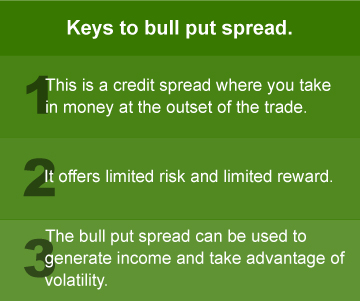Picking the right stock, picking the right direction, and picking the right time to buy or sell can sometimes be difficult. This is why, if you are familiar with the unique aspects and risks associated with options and are bullish about an investment over a specific period of time but want to limit your risk exposure, you may want to consider a bull put spread.
A bull put spread offers limited risk, while giving you different ways to profit from volatility in the underlying asset. This strategy is particularly attractive for assets that are expected to rise slightly, may fall slightly, or may remain unchanged, and when volatility—the level of uncertainty in the market or a specific security—is high.

Establishing a bull put spread is relatively straightforward: Sell one put option (short put) while simultaneously buying another put option (long put).
A bull put spread is also known as a vertical spread strategy (buying and selling options of the same underlying asset and expiration date) and a credit spread (you receive money at the outset of creating the position, and this is the maximum profit for the position). Because you are selling one put option and buying another, you are effectively hedging your position. The result is that potential gains and losses are capped.
When this strategy works
The bull put spread is used if you are moderately bullish on a stock or index, and your preference is to limit risk exposure. The primary goal is to make a short-term profit while limiting risk. You want the underlying asset (stock, index, etc.) to rise above both put options so they are out of the money (strike price is below the current market price), and the contracts expire worthless. If the options expire worthless, you keep the full credit you received.
What to look for before you initiate the trade
Before you initiate a bull put spread, it’s important to know what to look for. Here’s some helpful guidance:
- Underlying asset: First, you need to identify an underlying stock, index, or other asset that you believe will rise moderately or will remain unchanged over a specific period of time.
- Expiration date: Look at the option chain (the listing of put and call options, which shows strike prices, option premium, expiration date, etc.) for your chosen security, and choose an expiration date that matches your expected time frame. In certain circumstances, it may be advantageous to have a shorter time frame for a strategy like a bull put spread. This will most likely reduce the amount of premium (the price of the option) that you take in, but also reduces the possibility of an unforeseen event affecting the outcome of your trade. Make the appropriate selection based on your risk tolerances and investment expectations.
- Strike price: Next, assess the various strike prices of the option you choose. For example, you might select strike prices with at least a 5-point difference (i.e., buy the 30 put and sell the 35, or buy the 80 put and sell the 85). Choose strike prices that match your forecast for the underlying security and that may thus allow you to earn the maximum profit potential.
- Volatility: This is an important consideration. Think about whether you would prefer to initiate the bull put spread when volatility is relatively high (likely increasing both the amount of premium taken in and the risk associated with the trade) or when volatility is low (possibly reducing the premium taken in and the risk associated with the trade).
Tools to use
A valuable set of tools at your disposal when trading options are Greeks (i.e., delta, gamma, theta, vega, and rho).* Using Greeks can help you forecast how changes in price, time, and volatility can affect the value of your spreads.
Once your position is initiated, you should monitor it closely as you might need to take action before the contracts expire. The goal is to have both legs (each side of the spread—the buy side and the sell side) expire worthless to earn the maximum profit potential.
Bull put trade in action
Now that you have a basic idea of how this strategy works, let’s look at an example and a few specific scenarios.
- In April, you believe that XYZ stock, which is currently at $33 per share, will rise moderately over the next month or two to $35 per share or higher. You decide to initiate a bull put spread.
- You buy 1 XYZ May 30 put (long put) for $2.60, paying $260 ($2.60 x 100). Each options contract typically covers 100 shares, which is why you multiply the $2.60 premium by 100. At the same time, you sell 1 XYZ May 32 put (short put) for a limit price of $3.50, receiving $350 ($3.50 x 100). Our breakeven is $31.10 (highest strike price less the premium received). Notice in this example that the put we bought (long put) is out of the money and the put we sold (short put) is slightly out of the money. The stock could rise, remain unchanged, or fall slightly and still be profitable.
- Maximum profit: The credit received for this trade is $90 ($350−$260), less commission costs.
- Maximum risk: The maximum risk is the difference between the two strike prices, minus the credit you received. Therefore, maximum risk for this trade is $110 ($200−$90), plus commission costs.
Now, let’s look closely at what could hypothetically go right or wrong:
A winning trade: The underlying stock, XYZ, stays above the $32 strike price at the expiration date.
If the underlying stock stays above $32 at or before expiration, both puts remain out of the money. If both puts expire worthless, you get to keep the premium, minus transaction costs.
Assuming you want to exit the trade based on your strategy, you have a couple of options if you want to close the trade out in this scenario. First, you can close both legs of the trade. In the above example, the short put may fall from $3.50 to $0.90, while the long put may fall from $2.60 to $0.40. If you enter a limit order, an order is placed to buy to close the short put for $90, and sell to close the long put for $40. That gives you a net cost of $50. You originally received a credit of $90, minus the $50 cost, leaving you with a net profit of $40.
Second, if both options are out of the money, you can consider letting both legs expire worthless, achieving maximum profit. Depending on your specific risk and return objectives, you may want to consider closing both legs of the spread before expiration, once your profit goals are reached.
A losing trade: The underlying stock, XYZ, drops below the $32 strike price before the expiration date.
If the underlying stock drops below $30, and the option becomes in the money on or before expiration, both puts may rise in value. This is not what you expected or wanted. Your goal was to keep as much as possible of the $90 credit you originally received.
However, you should be prepared with a plan for exiting any strategy when things don’t quite go your way. Although the short put is costing you money, you are protected from the potentially substantial loss of that position by the long put. Nevertheless, in this scenario (both options are in the money), you can lose the maximum, or $110, if the stock drops below $30.
Trading options with Fidelity
Before creating a spread, you must fill out an options agreement and be approved for a Tier 2 options account. Contact your Fidelity representative if you have questions.
It is worth looking at an example to see how you might close a losing trade like this, assuming your outlook for the stock has changed and you no longer want to be in the position. The short put might rise from $3.50 to $4.80, while the long put could rise from $2.60 to $3.20. Before expiration, you could close both legs. You would place an order to buy to close the short put for $480, and sell to close the long put for $320.
In this example, you must pay $160 to exit the position ($480−$320), but you previously received a credit of $90. As a result, your total loss is a more manageable $70.
If you wait until expiration, you could lose the entire $110. Depending on your risk tolerance and objectives for the trade, you might choose to close both legs of a losing spread before expiration, especially when you no longer believe the stock will perform as anticipated.
Options traders should always be aware of early assignment, as well. There's a chance you’ll be assigned early (before expiration) on the short put. Actively monitor your option positions and learn to manage risk.


